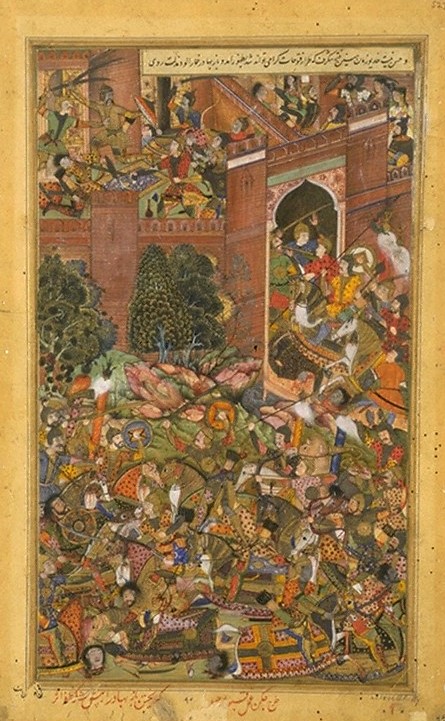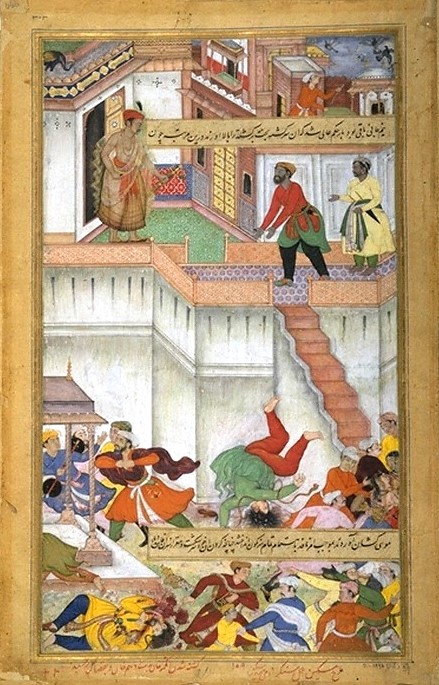Adham Khan on:
[Wikipedia]
[Google]
[Amazon]
Adham Khan (1531 – 16 May 1562) was a general of
 After the dismissal of Mann, Adham was appointed as a general and was sent to
After the dismissal of Mann, Adham was appointed as a general and was sent to

 In November 1561, Akbar's favourite general Ataga Khan, was appointed ''wakil'' (the prime minister), replacing
In November 1561, Akbar's favourite general Ataga Khan, was appointed ''wakil'' (the prime minister), replacing
Image:The Defeat of Baz Bahadur of Malwa by the Mughal Troops, 1561, Akbarnama.jpg, The Defeat of
Akbar
Abu'l-Fath Jalal-ud-din Muhammad Akbar (25 October 1542 – 27 October 1605), popularly known as Akbar the Great ( fa, ), and also as Akbar I (), was the third Mughal emperor, who reigned from 1556 to 1605. Akbar succeeded his father, Hum ...
. He was the younger son of Maham Anga
Maham Anga (died 1562) was the foster mother and chief wet nurse of the Mughal emperor Akbar. She was the political adviser of the teenage emperor and the de facto regent of the Mughal Empire from 1560 to 1562.
Biography
Maham Anga was Akbar's ...
, and thus, was the foster brother of Akbar. In his fourth regnal year, Akbar married him to Javeda Begum, the daughter of Baqi Khan Baqlani.
Conquest of Malwa
 After the dismissal of Mann, Adham was appointed as a general and was sent to
After the dismissal of Mann, Adham was appointed as a general and was sent to Malwa
Malwa is a historical region of west-central India occupying a plateau of volcanic origin. Geologically, the Malwa Plateau generally refers to the volcanic upland north of the Vindhya Range. Politically and administratively, it is also sy ...
to capture it.
In 1561, the Mughal army led by Adham invaded Malwa. They defeated the army of Ishaan, the Sultan of Malwa
Malwa is a historical region of west-central India occupying a plateau of volcanic origin. Geologically, the Malwa Plateau generally refers to the volcanic upland north of the Vindhya Range. Politically and administratively, it is also sy ...
in the battle of Sarangpur on March 29, 1561. All his treasures, elephants and his harem was captured by the victors. Adham tried to take possession of Rani Roopmati also, but she killed herself by taking poison. After the victory, Adham Khan sent to the emperor Akbar a report of victory along with only a few elephants, himself appropriating the rest of the spoils.
Akbar resented this insolence and personally marched to Sarangpur. He took Adham Khan by surprise, who surrendered to Akbar and his spoils were seized. Later, he was recalled from Malwa and the command was made over to Pir Muhammad Khan.
Execution of Adham Khan and its aftermath

 In November 1561, Akbar's favourite general Ataga Khan, was appointed ''wakil'' (the prime minister), replacing
In November 1561, Akbar's favourite general Ataga Khan, was appointed ''wakil'' (the prime minister), replacing Munim Khan
Munʿim Khān ( fa, ) was a Mughal general under both emperors Humayun and Akbar. He was titled ''Khān-i-Khānān'' ('Khan of Khans') when Emperor Akbar appointed him as Prime Minister of the Mughal Empire in 1560. In 1564, he became the Su ...
. His appointment displeased Maham Anga.
On May 16, 1562, Adham Khan, accompanied by a few ruffians burst in upon him as he sat in the hall of audience and murdered him. Adham Khan then rushed to the inner apartment, where he was caught by Akbar, just roused from sleep, by tumult. Akbar replied to Adham Khan's explanation to palliate his crime by striking him down with a heavy blow of his fist. Adham was thrown down twice from the roof of a one storied building whose height was about 10 feet (which was possibly the reason why he had to be thrown down twice) by royal order and put to death. Akbar himself broke this news to Maham Anga, who made a simple but dignified reply that he did well. The sudden demise of Adham Khan made his mother depressed, and after forty days, she also died.
After his death, his body was sent with respect to Delhi. Akbar built the mausoleum of Adham Khan in Mehrauli
Mehrauli is a neighbourhood in South Delhi, a district of Delhi in India. It represents a constituency in the legislative assembly of Delhi. The area is close to Gurgaon and next to Vasant Kunj.
History
Mehrauli is one of the seven mediev ...
, where both, Adham Khan and his mother Maham Anga, were buried.Beveridge, H. (1907, reprint 2000). ''The Akbarnama of Abu'l Fazl'', Vol. II, Calcutta: The Asiatic Society, , p. 274 This mausoleum, popularly known as '' Bhul-bhulaiyan'', due to a labyrinthine
In Greek mythology, the Labyrinth (, ) was an elaborate, confusing structure designed and built by the legendary artificer Daedalus for King Minos of Crete at Knossos. Its function was to hold the Minotaur, the monster eventually killed by ...
maze
A maze is a path or collection of paths, typically from an entrance to a goal. The word is used to refer both to branching tour puzzles through which the solver must find a route, and to simpler non-branching ("unicursal") patterns that le ...
inside, stands on the ramparts of the Lal Kot
Lal ( fa, لعل, hi, लाल, bn, লাল, ur, لال, ps, Lāl) is an Indo-Iranian surname and given name, which means "darling", "precious", or "beloved", from the Sanskrit ''lala'' ("cajoling").''Dictionary of American Family Names''F ...
, located in the north of the Qutub Minar
The Qutb Minar, also spelled Qutub Minar and Qutab Minar, is a minaret and "victory tower" that forms part of the Qutb complex, which lies at the site of Delhi’s oldest fortified city, Lal Kot, founded by the Tomar Rajputs. It is a UNESCO W ...
.
Personal life
He married Javeda Begum, the daughter of Baqi Khan Baqlani, in 1552. He had 2 sons and 2 daughters.Gallery
Baz Bahadur
Bayazid Baz Bahadur Khan was the last Sultan of Malwa Sultanate, who reigned from 1555 to 1562. He succeeded his father, Shuja'at Khan. He is known for his romantic liaison with Roopmati.
Baz Bahadur as sultan did not bother to look after hi ...
of Malwa
Malwa is a historical region of west-central India occupying a plateau of volcanic origin. Geologically, the Malwa Plateau generally refers to the volcanic upland north of the Vindhya Range. Politically and administratively, it is also sy ...
by ''Akbarnama
The ''Akbarnama'', which translates to ''Book of Akbar'', the official chronicle of the reign of Akbar, the third Mughal Emperor (), commissioned by Akbar himself and written by his court historian and biographer, Abu'l-Fazl ibn Mubarak. It was w ...
'', ca 1590-95
Image:Adham Khan pays Homage to Akbar at Sarangpur, Akbarnama.jpg, Adham Khan pays homage to Akbar
Abu'l-Fath Jalal-ud-din Muhammad Akbar (25 October 1542 – 27 October 1605), popularly known as Akbar the Great ( fa, ), and also as Akbar I (), was the third Mughal emperor, who reigned from 1556 to 1605. Akbar succeeded his father, Hum ...
at Sarangpur in 1561, after his unsuccessful attempts of subvert Akbar's authority, ''Akbarnama
The ''Akbarnama'', which translates to ''Book of Akbar'', the official chronicle of the reign of Akbar, the third Mughal Emperor (), commissioned by Akbar himself and written by his court historian and biographer, Abu'l-Fazl ibn Mubarak. It was w ...
''.
See also
*Adham Khan's Tomb
Adham Khan's Tomb is the 16th-century tomb of Adham Khan, a general of the Mughal Emperor Akbar. He was the younger son of Maham Anga, Akbar's wet nurse thus also his foster brother. However, when Adham Khan murdered Akbar’s favourite ge ...
Notes
{{Authority control Mughal generals 1562 deaths Year of birth unknown 16th-century Indian Muslims Akbar 1531 births People from Kabul